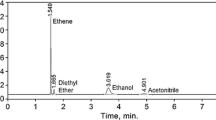Abstract
Dissociative chemisorption of ethanol on partially dehydroxylated silica is investigated by (i) exposing silica to gas-phase ethanol at various temperatures (ranging between 373 and 773 K) and (ii) analyzing the material using temperature-programmed desorption and in situ infrared spectroscopy. This chemisorption leads to formation of isolated surface ethoxide species via dehydration of ethanol at reaction temperatures above 573 K, and, at lower temperatures, it favors the synthesis of silanol–ethoxide functionality via a pathway involving opening of siloxane Si–O–Si bridges. The activation barrier for ethene desorption from the isolated surface ethoxide species is considerably higher relative to that for ethanol desorption from the hydrogen-bound silanol–ethoxide pairs. These single-turnover experiments allow predicting the product distribution of ethanol chemisorption on silica depending on the treatment conditions, e.g. temperature of interaction between ethanol and silica, and suggest why, in general, dehydration catalysis on silica requires high temperatures, in order to avoid non-productive chemisorption via opening of siloxane bridges.






Similar content being viewed by others
References
Natal-Santiago MA, Dumesic JA (1998) J Catal 175:252
Mertens G, Fripiat JJ (1973) J Colloid Interface Sci 42:169
Borello E, Zecchina A, Morterra C, Ghiotti G (1967) J Phys Chem 71:2945
Kondo S, Fujiwara H, Okazaki E, Ichii T (1980) J Colloid Interface Sci 74:328
Jeziorowski H, Knoezinger H, Meye W, Muller HD (1973) J Chem Soc Faraday Trans I 69:1744
Borello E, Zecchina A, Morterra C (1967) J Phys Chem 71:2938
Kubelkova L, Schurer P, Jiru P (1969) Surf Sci 18:245
Tedder LL, Lu GQ, Crowell JE (1991) J Appl Phys 69:7037
Danner JB, Vohs JM (1993) Appl Surf Sci 72:409
Kwak JH, Mei D, Peden CHF, Rousseau R, Szanyi J (2011) Catal Lett 141:649
Kim KS, Barteau MA, Farneth WE (1988) Langmuir 4:533
Tanabe K, Misono M, Ono Y, Hattori H (1989) New solid acids and bases: their catalytic properties, vol 51, Elsevier, Amsterdam
Lusvardi VS, Barteau MA, Farneth WE (1995) J Catal 153:41
Chiang H, Bhan A (2010) J Catal 271:251
Mirth G, Eder F, Lercher JA (1994) Appl Spectrosc 48:194
Zhuravlev LT (2000) Colloids Surf A 173:1
Redhead PA (1962) Vacuum 12:203
Jin T, Jo SK, Yoon C, White JM (1989) Chem Mater 1:308
Idriss H, Barteau MA (2000) Adv Catal 45:261
Fleischman SD, Scott SL (2011) J Am Chem Soc 133:4847–4855
Minibaev RF, Zhuravlev NA, Bagatur’yantz AA, Alfimov MV (2009) Russ Phys J 52:1164
Luts T, Iglesia E, Katz A (2011) J Mater Chem 21:982
Acknowledgment
The authors acknowledge funding by the Energy Biosciences Institute.
Author information
Authors and Affiliations
Corresponding author
Electronic supplementary material
Below is the link to the electronic supplementary material.
Rights and permissions
About this article
Cite this article
Luts, T., Katz, A. Chemisorption and Dehydration of Ethanol on Silica: Effect of Temperature on Selectivity. Top Catal 55, 84–92 (2012). https://doi.org/10.1007/s11244-012-9771-9
Published:
Issue Date:
DOI: https://doi.org/10.1007/s11244-012-9771-9




